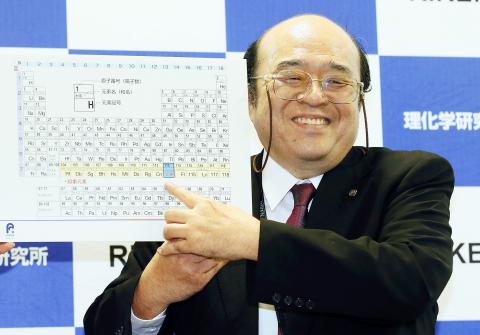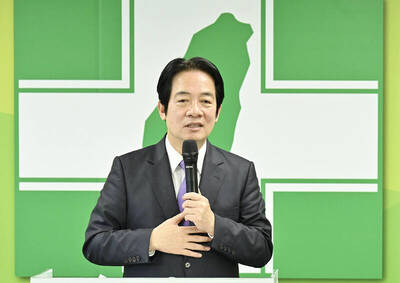At last, the periodic table looks tidy. To nobody’s surprise, the discoveries — and indeed creation — of elements number 113, 115, 117 and 118 were verified on Dec. 30 by the US-based International Union of Pure and Applied Chemistry (IUPAC), and the seventh period is now complete, giving the main table a nice, smooth bottom row.
The elements, discovered by scientists in Japan, Russia and America, are the first to be added to the table since 2011, when elements 114 and 116 were added.
IUPAC announced that a Russian-American team of scientists at the Joint Institute for Nuclear Research in Dubna and Lawrence Livermore National Laboratory in California had produced sufficient evidence to claim the discovery of elements 115, 117 and 118.

Photo: Kyodo News via AP
The body awarded credit for the discovery of element 113, which had also been claimed by the Russians and Americans, to a team of scientists from the Riken institute in Japan.
Kosuke Morita, who was leading the research at Riken, said his team now plans to “look to the unchartered territory of element 119 and beyond.”
Ryoji Noyori, former Riken president and Nobel laureate in chemistry said, “To scientists, this is of greater value than an Olympic gold medal.”
The elements, which currently bear placeholder names, will be officially named by the teams that discovered them in the coming months. Element 113 will be the first element to be named in Asia.
New elements can be named after a mythological concept, a mineral, a place or country, a property or a scientist. Once the names are settled upon, the world’s chemistry textbooks can be reprinted.
ELEMENTS OF INTRIGUE
Since we first began to understand that each element consists of a specific number of protons surrounded by the same number of electrons (and flavored with various numbers of neutrons), it has been easy to speculate about finding more. The Russian chemist Dmitri Mendeleev first arranged them in the now familiar way in 1869, having seen the table in a dream. Henceforth, if anyone asks you what the universe is, you can give (as a short answer): “This.” So here are some of the most intriguing elements on the all-singing, all-dancing new periodic table.
3. Lithium
Very weird stuff, lithium. At room temperature, it’s a solid metal that floats on water. If people with bipolar mood disorder swallow lithium compounds, it seems to smooth out their highs and lows. It is also responsible for the smartphone revolution (and perhaps an electric car one to follow), by making it possible to build light, powerful batteries. Much of the world’s available lithium is found in Bolivia and Peru, so it may yet turn the Andes into the new Middle East.
5. Boron
If you want to feel sorry for an element, go for boron. Numbers one and two (hydrogen and helium) make up stars. Three and four treat mental illness (lithium) and build rockets (beryllium). Six, seven and eight (carbon, nitrogen, oxygen) are the basic constituents of life. And there in the middle, at number five, sits boron, the stuff that makes silly putty soft yet bouncy.
54. Xenon
A fairly cool element, it must be said. It certainly has the coolest name, and like the other noble gases, helium, neon, argon, krypton (nothing to do with Superman) and radon, it just floats around not doing much. Under extreme pressure, however, xenon can be forced to make ultra-bright lights for massive cinemas.
83. Bismuth
The hipster element. No one’s heard of bismuth. Those who have, though, think it’s the last stable element before everything becomes radioactive (spontaneously breaks itself), but in fact it is just very, very, very, very un-radioactive. Generally, elements should behave a bit like the others around them, but bismuth doesn’t at all. Lead is poisonous, polonium is what killed Alexander Litvinenko and bismuth is the main ingredient in the stomach-settler Pepto-Bismol.
115. Ununpentium
Element number 115 will only be called ununpentium until its Russian discoverers come up with a better name. However, it has already been credited with some extremely far-fetched properties. According to Bob Lazar, a man who claimed to have worked on analyzing alien technology in Area 51, ununpentium is the fuel used in alien spacecraft. It isn’t.
76. Osmium
When children ask you, “What’s the heaviest naturally occurring element?”, after explaining that they mean “most dense”, give them the answer: “Osmium.” At this point, many smart-aleck children will say, “Don’t you mean iridium?” “No,” you can then say patiently. “That’s a common misconception based on mistaken measurement in the past.” Then buy them Theodore Gray’s superb The Elements app for their next birthday.
106, 105. Seaborgium, dubnium
Cold-war squabbling will be frozen into the periodic table for ever thanks to the rivalry between researchers in the University of California, Berkeley, led by Glenn Seaborg, and those at the Joint Institute for Nuclear Research in Dubna, Russia. The two teams discovered many radioactive heavy elements at similar times, and in secret, making it difficult to say who got there first. In 1997, the IUPAC finally decided to give dubnium to one side and seaborgium to the other — the only element ever named after a living person.
60. Neodymium
Makes really, really strong little magnets like the ones children play with and must never, ever swallow. While we’re down here, why are these two rows of elements — the lanthanides and actinides — set apart from all the others? Chemists have a secret answer to that: they actually belong in periods six and seven, but if you put them there the table would be too wide to print comfortably. Proof that nothing is ever really tidy.
47. Silver
Not cool for the reasons you think, but very cool for other ones. Solid silver is a strange thing to cherish in the form of coins or jewelry because it reacts with oxygen in the air and goes dark. When clean, however, it is the very shiniest element of all. It also conducts electricity better than any other element. When clean.
55. Caesium
The main thing everyone knows about the metal caesium is that it is so reactive that it will explode if you drop it in a bowl of water. Should you have any lying around, you could also watch it melt on a warm day as the temperature passes 28C. When not performing party tricks, caesium regulates the measurement of time for the human race by having a hyperfine atomic structure that is useful in atomic clocks.
Additional reporting by Guardian staff

May 11 to May 18 The original Taichung Railway Station was long thought to have been completely razed. Opening on May 15, 1905, the one-story wooden structure soon outgrew its purpose and was replaced in 1917 by a grandiose, Western-style station. During construction on the third-generation station in 2017, workers discovered the service pit for the original station’s locomotive depot. A year later, a small wooden building on site was determined by historians to be the first stationmaster’s office, built around 1908. With these findings, the Taichung Railway Station Cultural Park now boasts that it has

The latest Formosa poll released at the end of last month shows confidence in President William Lai (賴清德) plunged 8.1 percent, while satisfaction with the Lai administration fared worse with a drop of 8.5 percent. Those lacking confidence in Lai jumped by 6 percent and dissatisfaction in his administration spiked up 6.7 percent. Confidence in Lai is still strong at 48.6 percent, compared to 43 percent lacking confidence — but this is his worst result overall since he took office. For the first time, dissatisfaction with his administration surpassed satisfaction, 47.3 to 47.1 percent. Though statistically a tie, for most

Wooden houses wedged between concrete, crumbling brick facades with roofs gaping to the sky, and tiled art deco buildings down narrow alleyways: Taichung Central District’s (中區) aging architecture reveals both the allure and reality of the old downtown. From Indigenous settlement to capital under Qing Dynasty rule through to Japanese colonization, Taichung’s Central District holds a long and layered history. The bygone beauty of its streets once earned it the nickname “Little Kyoto.” Since the late eighties, however, the shifting of economic and government centers westward signaled a gradual decline in the area’s evolving fortunes. With the regeneration of the once

In February of this year the Taipei Times reported on the visit of Lienchiang County Commissioner Wang Chung-ming (王忠銘) of the Chinese Nationalist Party (KMT) and a delegation to a lantern festival in Fuzhou’s Mawei District in Fujian Province. “Today, Mawei and Matsu jointly marked the lantern festival,” Wang was quoted as saying, adding that both sides “being of one people,” is a cause for joy. Wang was passing around a common claim of officials of the People’s Republic of China (PRC) and the PRC’s allies and supporters in Taiwan — KMT and the Taiwan People’s Party — and elsewhere: Taiwan and